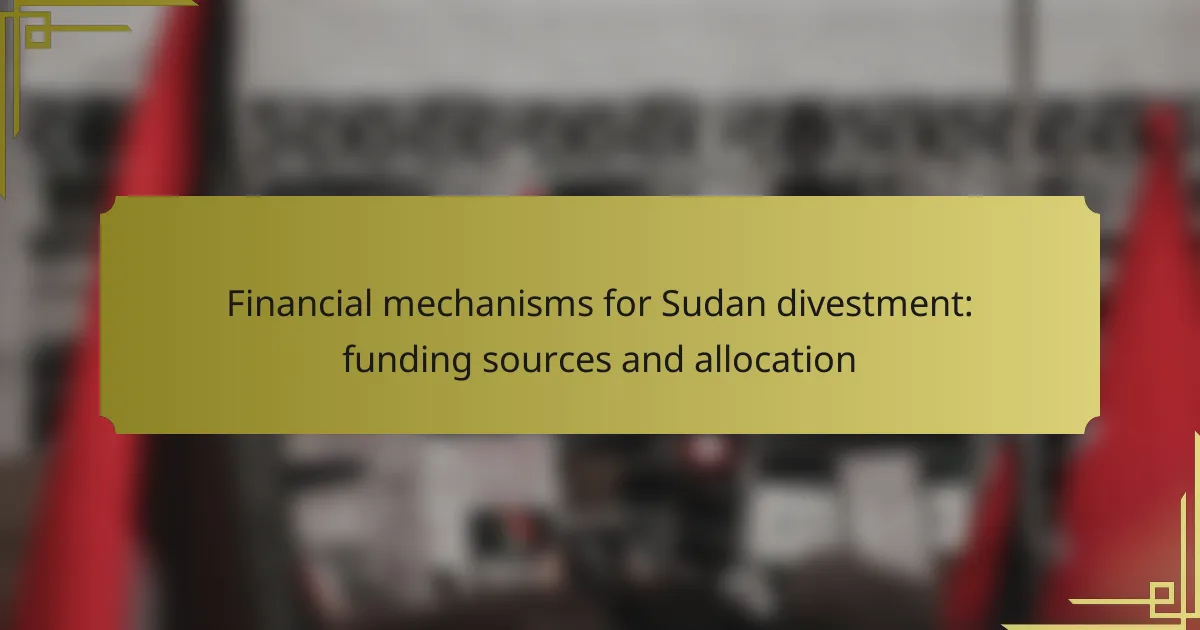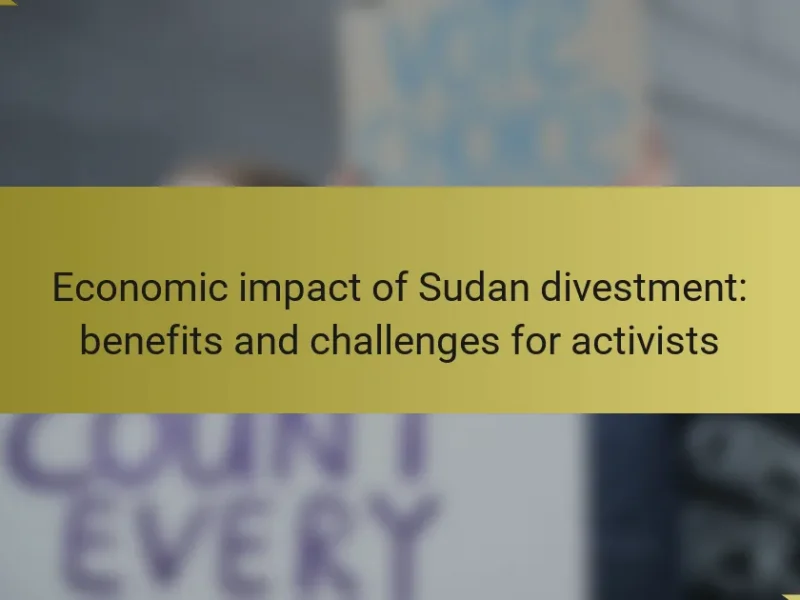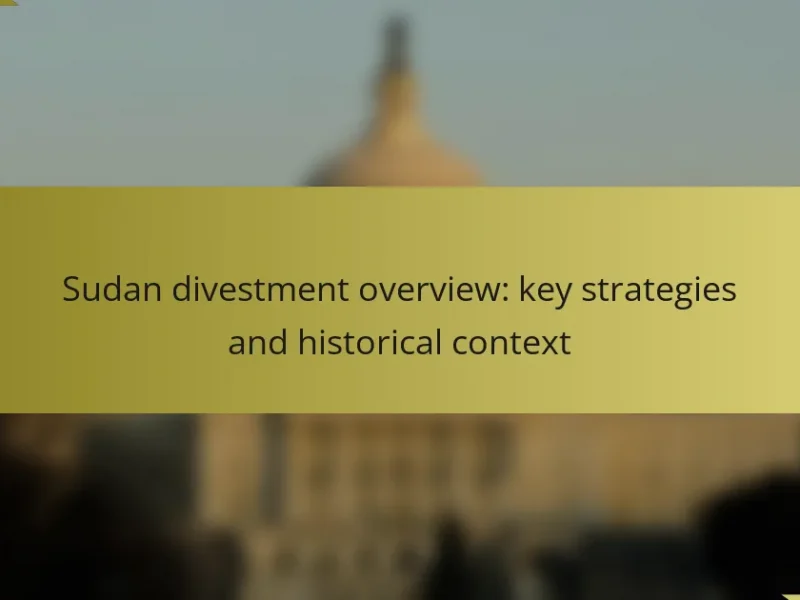Sudan divestment involves financial mechanisms aimed at withdrawing investments from entities that support the Sudanese government. Key strategies include shareholder resolutions, state-level divestment laws, and negative screening by institutional investors, all designed to exert economic pressure on the regime. Funding sources for these divestment efforts consist of institutional investors, socially responsible investment funds, and government grants, which align with ethical standards and humanitarian goals. The allocation of funds focuses on supporting humanitarian initiatives and development projects while ensuring transparency in tracking the distribution of resources. Reports from organizations such as the Sudan Divestment Task Force provide essential data on funding distribution and its impact on local communities.
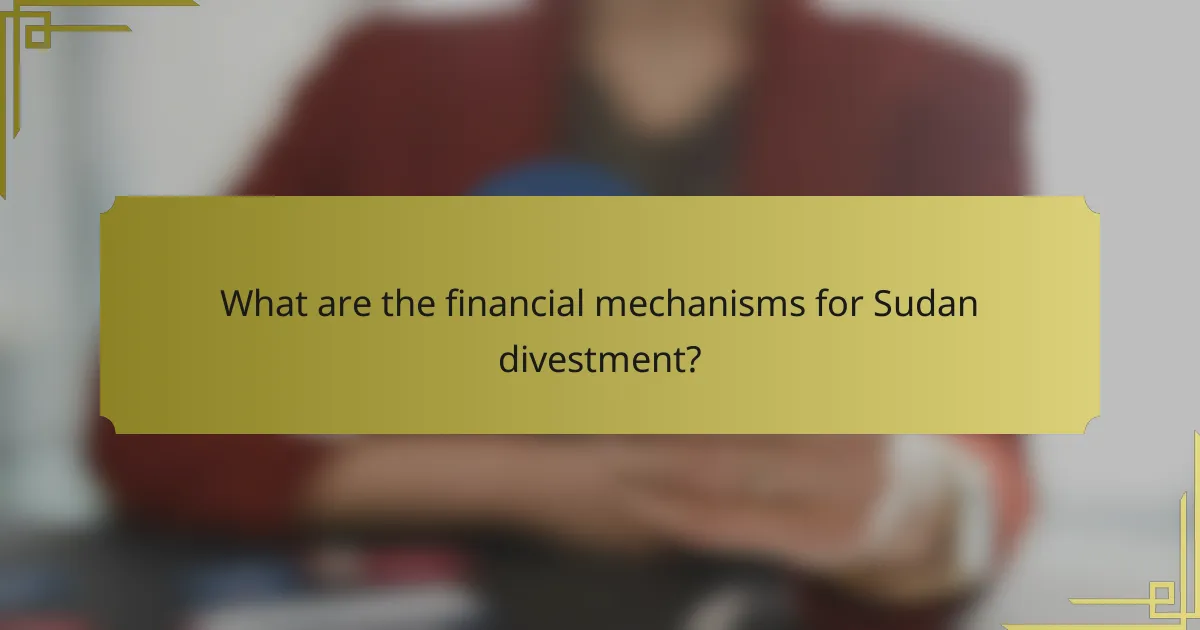
What are the financial mechanisms for Sudan divestment?
Sudan divestment employs various financial mechanisms to withdraw investments from entities supporting the Sudanese government. These mechanisms include shareholder resolutions, which pressure companies to cease operations in Sudan. Additionally, state-level divestment laws mandate the withdrawal of public funds from companies operating in Sudan. Institutional investors often implement negative screening, avoiding investments in firms with ties to the Sudanese regime. Furthermore, advocacy groups promote grassroots campaigns, urging individuals and organizations to divest. These strategies collectively aim to apply economic pressure on the Sudanese government to change its policies.
How do these mechanisms function in the context of divestment?
Divestment mechanisms function by reallocating financial resources away from entities linked to harmful practices. They aim to pressure those entities to change their behavior by reducing their capital. Investors, including institutions and individuals, withdraw funds from companies involved in unethical activities. This withdrawal can lead to a decrease in stock prices and market value. As a result, companies may feel compelled to alter their practices to regain investor confidence. Historical examples show that divestment has influenced corporate policies in various sectors. For instance, the anti-apartheid movement effectively used divestment to challenge South Africa’s regime. This demonstrates that financial mechanisms can be powerful tools for social change through strategic funding reallocation.
What are the key components of these financial mechanisms?
The key components of financial mechanisms for Sudan divestment include funding sources, allocation strategies, and regulatory frameworks. Funding sources can be public, private, or philanthropic, providing the necessary capital for divestment initiatives. Allocation strategies determine how funds are distributed to various projects or organizations involved in divestment efforts. Regulatory frameworks establish the legal and policy guidelines that govern these financial mechanisms, ensuring compliance and effectiveness. Together, these components create a structured approach to facilitate divestment from Sudan, aiming to achieve social and economic objectives while adhering to ethical standards.
How do these components interact to facilitate divestment?
Divestment components interact through financial strategies, regulatory frameworks, and stakeholder engagement. Financial strategies involve reallocating investments away from entities linked to Sudan. Regulatory frameworks establish guidelines that support divestment actions. Stakeholder engagement ensures that investors, governments, and NGOs collaborate effectively.
These interactions create a cohesive approach to divestment. For instance, financial strategies can be influenced by regulatory incentives. Stakeholder engagement can drive compliance with these regulations. Together, these components streamline the divestment process, making it more efficient and impactful.
The effectiveness of this interaction is evident in successful divestment campaigns. Historical examples show that coordinated efforts lead to significant financial pressure on targeted entities. This pressure often results in policy changes or improved conditions within the divested regions.
Why is Sudan divestment important for financial stakeholders?
Sudan divestment is important for financial stakeholders because it mitigates financial risk associated with investments in regions with political instability. Political instability in Sudan has led to economic sanctions and international isolation. These conditions can result in significant financial losses for stakeholders. Additionally, divestment aligns with ethical investment practices. Many investors prioritize social responsibility and sustainability. By divesting from Sudan, financial stakeholders can enhance their reputational value. This can attract more socially conscious investors. Furthermore, divestment can influence policy changes in Sudan. It sends a clear message that unethical practices will not be tolerated. Thus, Sudan divestment serves both financial and ethical interests for stakeholders.
What risks are associated with investing in Sudan?
Investing in Sudan carries significant risks. Political instability is a primary concern, as the country has experienced ongoing conflict and governance challenges. Economic volatility is also prevalent, with high inflation rates affecting currency stability. Additionally, there are concerns regarding regulatory uncertainty, which can impact investment returns. Corruption remains a significant issue, undermining trust in business operations. Furthermore, potential sanctions from international bodies can create barriers for foreign investors. The lack of infrastructure poses challenges for operational efficiency. Lastly, the humanitarian situation can disrupt markets and affect business sustainability.
How does divestment impact the financial landscape in Sudan?
Divestment significantly impacts the financial landscape in Sudan by reducing foreign investment and capital inflows. This reduction leads to decreased economic growth and limited access to financial resources. As companies withdraw investments, job opportunities diminish, resulting in higher unemployment rates. Additionally, divestment can weaken the Sudanese currency, leading to inflation. The withdrawal of funds also hampers infrastructure development and social services, exacerbating poverty levels. Historical instances, such as the divestment movements in response to the Darfur conflict, illustrate these effects, where capital flight negatively influenced Sudan’s economy.
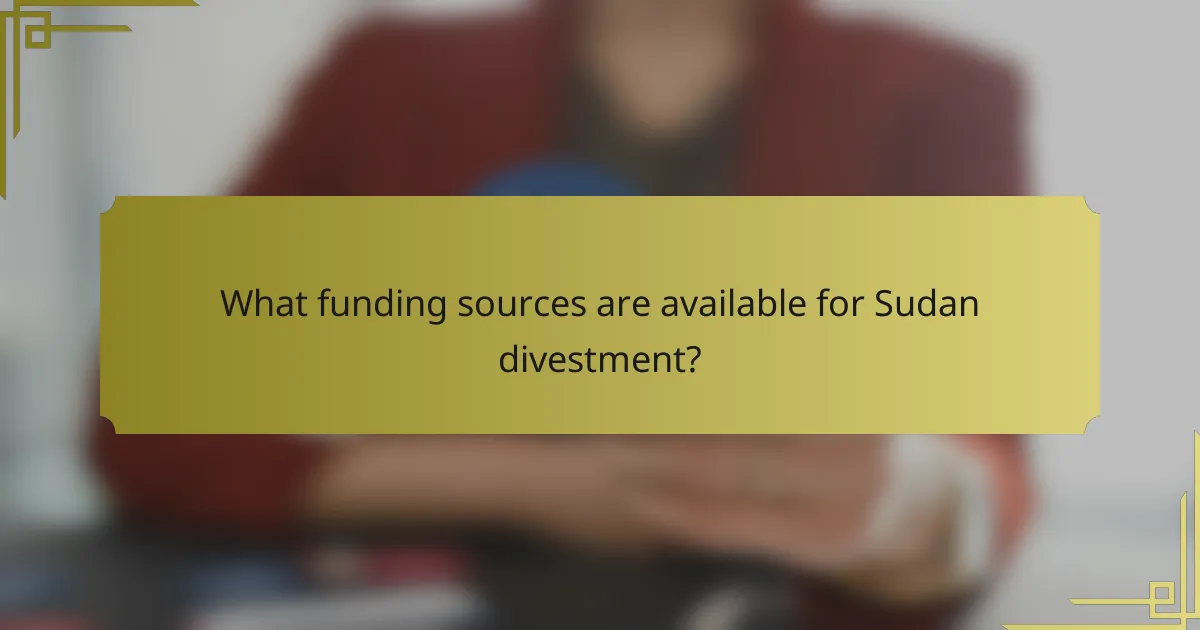
What funding sources are available for Sudan divestment?
Funding sources available for Sudan divestment include institutional investors, socially responsible investment funds, and government grants. Institutional investors often seek to align their portfolios with ethical standards. Socially responsible investment funds specifically target divestment from companies linked to human rights abuses. Government grants may support initiatives aimed at promoting peace and stability in Sudan. These sources collectively provide financial support for divestment efforts focused on ethical considerations and humanitarian goals.
How do public and private sectors contribute to funding?
Public and private sectors contribute to funding through various mechanisms. The public sector primarily provides funding through government budgets, grants, and subsidies. Governments allocate resources for development projects, infrastructure, and social programs. For instance, in Sudan, international aid from governments supports humanitarian efforts and economic recovery.
The private sector contributes through investments, loans, and philanthropic donations. Corporations may invest in local businesses or fund community projects. For example, private companies often engage in corporate social responsibility initiatives that provide financial support to underserved communities.
Both sectors can collaborate on funding initiatives. Public-private partnerships leverage resources from both sides to achieve common goals. In Sudan, these partnerships can enhance the effectiveness of funding efforts aimed at economic development. Overall, the combined contributions of these sectors play a crucial role in addressing funding needs.
What role do international organizations play in funding?
International organizations play a crucial role in funding by providing financial resources for development and humanitarian projects. They mobilize funds from member states and other sources to support initiatives in various countries. Organizations like the World Bank and the International Monetary Fund allocate funds to projects aimed at poverty alleviation and infrastructure development. In the context of Sudan, these organizations can facilitate divestment by offering financial assistance to promote stability and economic growth. Their funding often comes with technical expertise and policy guidance, ensuring effective use of resources. For instance, the World Bank has invested billions in Sudanese projects aimed at improving governance and economic conditions.
How can local investors participate in divestment funding?
Local investors can participate in divestment funding by allocating capital to projects that align with divestment goals. They can invest in companies or funds that focus on sustainable and ethical practices. Additionally, local investors can join coalitions or networks that promote divestment initiatives. These groups often provide resources and guidance on investment opportunities. Engaging with local communities and stakeholders can also enhance their participation. By collaborating, investors can amplify their impact on divestment efforts. This approach is supported by the growing trend of socially responsible investing, which has seen a significant increase in assets, reaching over $17 trillion in the U.S. alone as of 2020.
What alternative funding sources exist for divestment efforts?
Alternative funding sources for divestment efforts include philanthropic contributions, crowdfunding campaigns, and impact investing. Philanthropic contributions often come from foundations dedicated to social change. Crowdfunding campaigns allow individuals to support divestment initiatives directly. Impact investing focuses on generating social or environmental benefits alongside financial returns. Additionally, community investment funds can provide local resources for divestment efforts. These sources collectively enhance the financial capacity to pursue divestment goals effectively.
How do grants and donations support divestment initiatives?
Grants and donations provide essential financial resources for divestment initiatives. They enable organizations to withdraw investments from entities involved in unethical practices. This funding supports research, advocacy, and public awareness campaigns. For instance, grants can cover operational costs and facilitate strategic planning. Donations often come from individuals or foundations committed to social justice. These contributions empower grassroots movements to challenge harmful investments. Additionally, financial support can enhance collaboration among various stakeholders. This collective effort amplifies the impact of divestment strategies. Ultimately, grants and donations are crucial for sustaining and expanding divestment initiatives.
What impact do crowdfunding platforms have on funding sources?
Crowdfunding platforms significantly diversify funding sources. They enable individuals and organizations to raise funds from a large number of small contributions. This model shifts funding away from traditional investors like banks and venture capitalists. Crowdfunding platforms often attract a global audience, increasing the potential donor pool. They also empower grassroots movements and social causes, allowing for funding that may not align with conventional investment criteria. A report by the World Bank indicates that crowdfunding can mobilize resources quickly, especially for initiatives in developing regions. This democratization of funding sources can stimulate innovation and support projects that address specific community needs.
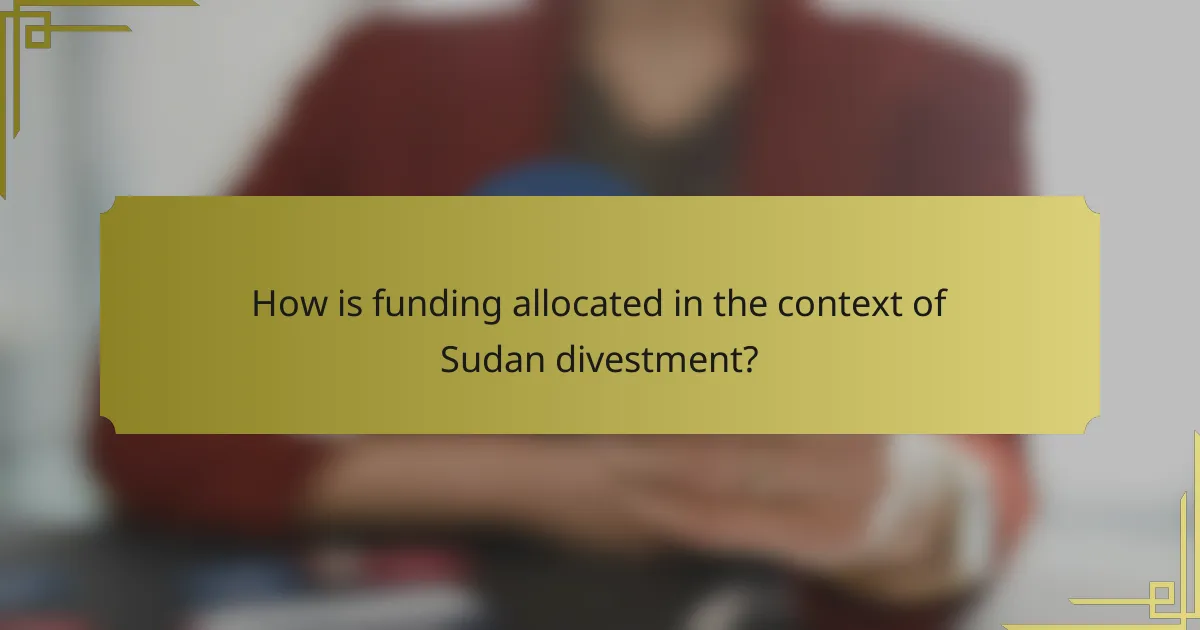
How is funding allocated in the context of Sudan divestment?
Funding for Sudan divestment is allocated primarily through public and private sector initiatives. Organizations and governments withdraw investments from companies operating in Sudan. This withdrawal often targets sectors that support human rights violations.
Funds are redirected to support humanitarian efforts and development projects. Additionally, divestment campaigns raise awareness and mobilize financial resources. The allocation process involves assessing the impact of investments on local communities.
Reports from entities like the Sudan Divestment Task Force provide data on funding distribution. They highlight the importance of transparency in tracking allocated funds. This ensures that resources effectively support the intended humanitarian goals.
What criteria are used to determine funding allocation?
Funding allocation criteria include project viability, alignment with strategic goals, and potential impact. Project viability assesses the feasibility and sustainability of the initiative. Alignment with strategic goals ensures the funding supports overarching objectives. Potential impact evaluates the expected outcomes and benefits of the funded project. Additional factors may include cost-effectiveness, urgency of need, and community support. These criteria are designed to maximize the effectiveness of funds while addressing critical needs.
How do stakeholders prioritize projects for funding?
Stakeholders prioritize projects for funding by evaluating criteria such as alignment with strategic goals, potential impact, and risk assessment. They assess how each project contributes to broader objectives. Stakeholders also consider the financial viability and resource availability for each project. Additionally, stakeholder engagement and community needs play a critical role in decision-making. Historical data shows that projects with clear, measurable outcomes are more likely to receive funding. This structured approach ensures that resources are allocated effectively to projects that promise the highest returns on investment.
What role does transparency play in funding allocation?
Transparency ensures accountability in funding allocation. It allows stakeholders to understand how funds are distributed and used. This clarity builds trust among donors, recipients, and the public. Increased transparency often leads to better decision-making and resource management. Research shows that transparent processes can reduce corruption and misallocation of funds. For example, the International Aid Transparency Initiative promotes open data on aid flows. Such initiatives help ensure that funds reach intended beneficiaries effectively. Overall, transparency plays a critical role in enhancing the efficiency and impact of funding allocation.
What challenges are faced in the allocation of funds?
Challenges in the allocation of funds include lack of transparency and accountability. Limited oversight can lead to mismanagement of resources. Competing priorities among stakeholders often complicate decision-making. Inadequate data on needs and impacts hinders effective allocation. Political instability can disrupt funding flows and commitments. Additionally, bureaucratic hurdles slow down the disbursement process. These challenges can ultimately impede the effectiveness of financial mechanisms aimed at Sudan divestment.
How do political factors influence funding allocation decisions?
Political factors significantly influence funding allocation decisions by shaping priorities and determining eligibility for resources. Government policies often dictate which sectors receive funding based on political agendas. For instance, political stability can attract more investment and funding. Conversely, political unrest may lead to reduced funding opportunities. Lobbying efforts by interest groups can also sway funding allocations. These groups advocate for specific causes that align with their interests. Historical examples show that funding can be redirected based on changing administrations. In the context of Sudan divestment, political pressure from advocacy groups can influence decisions on resource allocation.
What are the implications of misallocation of funds?
Misallocation of funds leads to inefficient use of financial resources. It can result in critical projects being underfunded or delayed. Essential services may suffer due to lack of financial support. This mismanagement can exacerbate economic instability. In the context of Sudan divestment, it may hinder effective humanitarian aid. Historical examples show that misallocation often leads to increased poverty levels. Furthermore, it can damage trust between stakeholders and investors. Ultimately, misallocation undermines the intended impact of funding initiatives.
What best practices can enhance funding allocation for Sudan divestment?
Establishing transparent funding criteria enhances allocation for Sudan divestment. Clear criteria ensure that funds are directed towards initiatives with measurable impact. Engaging stakeholders, including local communities and NGOs, fosters trust and accountability. Regular audits and assessments of funded projects can improve efficiency and effectiveness. Leveraging partnerships with international organizations can increase funding opportunities. Utilizing technology for tracking and reporting can enhance transparency. Implementing a phased funding approach allows for adjustments based on project performance. These practices collectively contribute to a more effective funding allocation strategy for Sudan divestment.
How can organizations improve transparency in funding allocation?
Organizations can improve transparency in funding allocation by implementing clear reporting practices. They should establish standardized financial reporting formats. Regularly publishing detailed financial statements increases accountability. Utilizing independent audits can ensure accuracy and build trust. Engaging stakeholders in the budgeting process fosters openness. Training staff on transparency principles enhances internal compliance. Additionally, leveraging technology for real-time data sharing promotes accessibility. Research shows that transparent organizations attract more funding and support.
What strategies can be implemented to ensure effective use of funds?
Implementing a budget plan is a key strategy for effective use of funds. A budget plan outlines income and expenses clearly. This allows for tracking financial resources efficiently. Prioritizing expenditures based on necessity enhances fund allocation. Regular financial reviews help identify unnecessary spending. Engaging stakeholders in financial decisions promotes transparency. Utilizing financial management software increases accuracy in fund tracking. Lastly, setting measurable goals ensures funds are used effectively for intended purposes.
The main entity of this article is the financial mechanisms for Sudan divestment, which involves strategies to withdraw investments from entities supporting the Sudanese government. The article outlines various financial mechanisms, including shareholder resolutions, state-level divestment laws, and negative screening by institutional investors. It discusses the key components of these mechanisms, such as funding sources, allocation strategies, and regulatory frameworks, and how they interact to facilitate divestment. Additionally, the article highlights the importance of divestment for financial stakeholders, the risks associated with investing in Sudan, and the impact of divestment on the financial landscape. Finally, it explores funding allocation criteria, the role of transparency, and best practices for enhancing funding effectiveness in divestment efforts.
